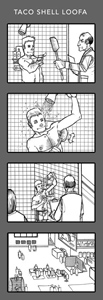Using and Understanding Media
Use the title to predict what the chapter will cover.
Learning Objectives
A chapter's learning objectives help you determine what the writers want you to learn.
In this lesson, you will learn
- how to understand media purposes;
- how to determine a message's intended audience;
- steps for developing media messages; and
- persuasive techniques in the media.
We are surrounded by messages in media. From magazines and newspapers to the Internet and TV, we are constantly bombarded with media. It is important to learn how to interpret these messages.
The overview often provides the main ideas in a chapter.
Media Literacy Basics
Headings of different font sizes and colors give you an idea of connected information.
Purpose
Subheadings indicate relationships to higher level headings.
All media has a purpose. Often it is to sell or influence. Sometimes the purpose is simply to entertain or inform. In most cases, however, even media that appears to be entertainment or news has additional purposes. They may have a political bias.
Audience
Subheadings indicate relationships to higher level headings.
Media producers always have an audience in mind. They aim their messages at specific demographics. They picture their audience's ethnicity, age, gender, income level, and/or location. Think of some of the truck commercials you see. Often they appeal to men who are proud to be Texans.
Message
Subheadings indicate relationships to higher level headings.
As in a book or article, electronic media always has a message, but it may not be easy to determine. The message is seldom stated directly. You will often have to infer the message.
Questions
Questions and activities help you see what material the chapter writers want you to learn as you read.
1. What would be the main purpose of a TV commercial? How about the news?
2. When developing advertisements to be shown during a football game, what target audience do you think the producers will have in mind? How about a movie about teenage girls?
Steps in Developing TV or Film
Sidebars provide connecting materials set off from the main content.
1. Script Writing
Subheadings indicate relationships to higher level headings.
The first step in developing a TV show or movie is to write a script. The script is like a play. It includes the story as well as each actor's lines and stage directions.
2. Storyboarding
Subheadings indicate relationships to higher level headings.
A storyboard is a visual portrayal of the script. An artist sketches each scene much like a comic strip. This storyboard was made for a Taco Bell commercial.
3. Visuals
Subheadings indicate relationships to higher level headings.
Visuals in a play would include props and costumes. On TV and in movies, the visuals include camera angles and special effects.
|
Camera Angles |
Purposes |
|
Close-up shots show facial expressions and emotions. |
To give the audience an emotional connection to characters |
|
Long shots show the larger context of a scene. |
To give the audience a good idea of the context of a scene |
|
Low-angle shots look up at characters. |
To make the character look important or threatening |
|
High-angle shots look down at characters. |
To make the character look unimportant, small, or vulnerable |
Tables and charts organize content in a way that shows relationships in content.
